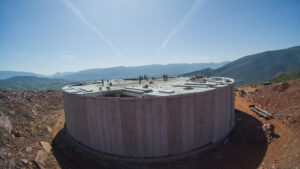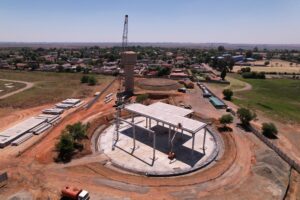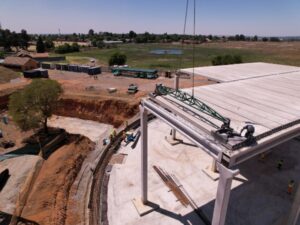The real potential of precast concrete is yet to be fully harnessed in South Africa to significantly fast-track the construction of quality water infrastructure.
However, with sound upfront planning of the execution of these construction projects, more quality prefabricated reservoirs, water towers and water and wastewater-treatment facilities could be built to alleviate the serious water and sanitation crisis. “To successfully execute a large precast-concrete project requires sound upfront planning. Engineering designs and drawings, as well as the co-ordination of services need to be finalised before manufacture of the various precast-concrete elements can start. This requires input from all members of the professional team, including the project engineer, mechanical consultant, main contractor and the precast-concrete specialist. Bear in mind that there is very little scope for variations in the works programme once a precast-concrete construction project is underway. This is considering that the precast-concrete elements are manufactured to exacting specifications during the preliminary stages, such as earthworks, site terracing and foundation work,” says Willie de Jager, MD of Corestruc. Barriers to entry These projects also rely on extensive skills and experience across the entire precast-concrete value chain. This includes design, manufacture, transport and rigging capabilities to integrate the various prefabricated concrete elements that constitute the structure. He noted that each function had a critical role to play, and a weak link anywhere in the value chain would jeopardise the project. Corestruc’s systems have been set up specifically for the construction of reservoirs and water towers, among other structures. To do so, requires a sizeable capital investment, restricting many more participants from entering the market to help drive greater uptake of the technology.
Furthermore, there is a long lead time between the research and development phases and commercialisation of precast-concrete systems. For example, it took about four years for Corestruc to perfect its prefabricated concrete water towers, which are 35 m in height and have a storage capacity of between 1.5 Mℓ and 5 Mℓ. The company is currently constructing two of these water towers.
They complement the many precast-concrete reservoirs and prefabricated roof structures for cast-in-place reservoirs that the company has already built for municipalities. It took the contractor significantly longer to take this system to market. “Each time, it has been an extensive process of trial and error, returning from site to further refine the design and our processes until it works,” adds De Jager.
However, the effort has been worth it. Already, Corestruc has helped to fast-track the construction of about 500 Mℓ of water-storage capacity, with many more reservoir projects already underway. This includes an open-top water-retaining tank with a wall height of 8.5 m and total diameter of 41.71 m for one of the country’s leading miners of platinum-group metals.
Advantages
These projects also rely on extensive skills and experience across the entire precast-concrete value chain. This includes design, manufacture, transport and rigging capabilities to integrate the various prefabricated concrete elements that constitute the structure. He noted that each function had a critical role to play, and a weak link anywhere in the value chain would jeopardise the project. Corestruc’s systems have been set up specifically for the construction of reservoirs and water towers, among other structures. To do so, requires a sizeable capital investment, restricting many more participants from entering the market to help drive greater uptake of the technology.
Furthermore, there is a long lead time between the research and development phases and commercialisation of precast-concrete systems. For example, it took about four years for Corestruc to perfect its prefabricated concrete water towers, which are 35 m in height and have a storage capacity of between 1.5 Mℓ and 5 Mℓ. The company is currently constructing two of these water towers.
They complement the many precast-concrete reservoirs and prefabricated roof structures for cast-in-place reservoirs that the company has already built for municipalities. It took the contractor significantly longer to take this system to market. “Each time, it has been an extensive process of trial and error, returning from site to further refine the design and our processes until it works,” adds De Jager.
However, the effort has been worth it. Already, Corestruc has helped to fast-track the construction of about 500 Mℓ of water-storage capacity, with many more reservoir projects already underway. This includes an open-top water-retaining tank with a wall height of 8.5 m and total diameter of 41.71 m for one of the country’s leading miners of platinum-group metals.
Advantages
 De Jager states that precast-concrete reservoirs are significantly faster to construct. For example, the company has built 10 Mℓ and 30 Mℓ reservoirs in four and six months, respectively. However, concrete prefabrication may not always be much faster than traditional in-situ concrete construction. In these instances, precast concrete facilitates a sound project start considering that the various precast-concrete elements that constitute the entire structure or sizeable portion thereof are already being manufactured during the earthworks, site terracing and construction of the foundations. There are further benefits of precast concrete, not least of which are the high quality and durability of the final precast-concrete structure.
De Jager states that precast-concrete reservoirs are significantly faster to construct. For example, the company has built 10 Mℓ and 30 Mℓ reservoirs in four and six months, respectively. However, concrete prefabrication may not always be much faster than traditional in-situ concrete construction. In these instances, precast concrete facilitates a sound project start considering that the various precast-concrete elements that constitute the entire structure or sizeable portion thereof are already being manufactured during the earthworks, site terracing and construction of the foundations. There are further benefits of precast concrete, not least of which are the high quality and durability of the final precast-concrete structure.
 Accurate manufacture in precast-concrete factories facilitates the optimal use of materials, reducing waste. Furthermore, prefabrication enables the use of more efficient design of concrete element shapes that would otherwise be too costly or complicated to execute with cast-in-place construction methods.
To remain competitive, precast-concrete factories must also use energy and water efficiently. In these ways, they further reduce the carbon footprint of the concrete elements that are integrated on site. Considering increasing utility costs, precast companies had to continue finding ways of reducing their reliance on grid supplies.
“Just about everything built in other countries of the world is prefabricated because it is more efficient and cost-effective to construct quality infrastructure in this manner. As a country, we are still undergoing a very steep learning curve, in terms of the design and application of the technology. As our water crisis deepens, we will have no other choice to find more innovative ways of accelerating the construction of top-notch infrastructure in a cost-effective manner. Precast concrete provides such potential,” concludes De Jager.
Accurate manufacture in precast-concrete factories facilitates the optimal use of materials, reducing waste. Furthermore, prefabrication enables the use of more efficient design of concrete element shapes that would otherwise be too costly or complicated to execute with cast-in-place construction methods.
To remain competitive, precast-concrete factories must also use energy and water efficiently. In these ways, they further reduce the carbon footprint of the concrete elements that are integrated on site. Considering increasing utility costs, precast companies had to continue finding ways of reducing their reliance on grid supplies.
“Just about everything built in other countries of the world is prefabricated because it is more efficient and cost-effective to construct quality infrastructure in this manner. As a country, we are still undergoing a very steep learning curve, in terms of the design and application of the technology. As our water crisis deepens, we will have no other choice to find more innovative ways of accelerating the construction of top-notch infrastructure in a cost-effective manner. Precast concrete provides such potential,” concludes De Jager.






